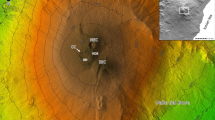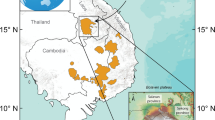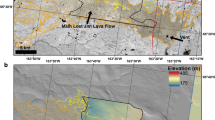Abstract
Using a lava flow emplacement model and a satellite-based land cover classification, we produce a map to allow assessment of the type and quantity of natural, agricultural and urban land cover at risk from lava flow invasion. The first step is to produce lava effusion rate contours, i.e., lines linking distances down a volcano’s flank that a lava flow will likely extend if fed at a given effusion rate from a predetermined vent zone. This involves first identifying a vent mask and then running a downhill flow path model from the edge of every pixel around the vent mask perimeter to the edge of the DEM. To do this, we run a stochastic model whereby the flow path is projected 1,000 times from every pixel around the vent mask perimeter with random noise being added to the DEM with each run so that a slightly different flow path is generated with each run. The FLOWGO lava flow model is then run down each path, at a series of effusion rates, to determine likely run-out distance for channel-fed flow extending down each path. These results are used to plot effusion rate contours. Finally, effusion rate contours are projected onto a land classification map (produced from an ASTER image of Etna) to assess the type and amount of each land cover class falling within each contour. The resulting maps are designed to provide a quick look-up capability to assess the type of land at risk from lava extending from any location at a range of likely effusion rates. For our first (2,000 m) vent zone case used for Etna, we find a total of area of ~680 km2 is at risk from flows fed at 40 m3 s−1, of which ~6 km2 is urban, ~150 km2 is agriculture and ~270 km2 is grass/woodland. The model can also be run for specific cases, where we find that Etna’s 1669 vent location, if active today, would likely inundate almost 11 km2 of urban land, as well as 15.6 km2 of agricultural land, including 9.5 km2 of olive groves and 5.2 km2 of vineyards and fruit/nut orchards.










Similar content being viewed by others
References
Alexis H, Vicari A, Ciraudo A, Del Negro C (2009) Forecasting lava flow hazards during the 2006 Etna eruption: using the MAGFLOW cellular automata model. Comput Geosci 35:1050–1060
Andronico D, Branca S, Calvari S, Burton M, Caltabiano T, Corsaro RA, Del Carlo P, Garfi G, Lodato L, Miragila L, Murè F, Neri M, Pecora E, Pompilio M, Salerno G, Spampinato L (2005) A multi-disciplinary study of the 2002–2003 Etna eruption: insights into a complex plumbing system. Bull Volcanol 67:314–330
Baker JD, Littnan CL, Johnston DW (2006) Potential effects of sea level rise on the terrestrial habitats of endangered species and endemic megafauna in the Northwestern Hawaiian Islands. Endang Species Res 4:1–10
Barberi F, Carapezza ML, Valenza M, Villari L (1993) The control of lava flow during the 1991–1992 eruption of Mt. Etna. J Volcanol Geotherm Res 56:1–34
Barca D, Crisci GM, Di Gregorio S, Nicoletta F (1993) Cellular automata methods for modeling lava flows: simulation of the 1986–1987 eruption, Mount Etna, Sicily. In: Kilburn CRJ, Luongo G (eds) Active lavas. UCL Press, London, pp 291–309
Behncke B, Neri M (2003) The July–August 2001 eruption of Mt. Etna (Sicily). Bull Volcanol 65:461–476
Behncke B, Neri M, Nagay A (2005) Lava flow hazard at Mount Etna (Italy): new data from a GIS-based study. Geol Soc Am Special Paper 396:189–207
Bisson M, Behncke B, Fornaciai A, Neri M (2009) LiDAR-based digital terrain analysis of an area exposed to the risk of lava flow invasion: the Zafferana Etnea territory, Mt. Etna (Italy). Nat Hazards 50:321–334
Blong RJ (1984) Volcanic hazards. Academic Press, Sydney, 424 p
Bonne K, Kervyn M, Cascone L, Njome S, Van Ranst E, Suh E, Ayonghe S, Jacobs P, Ernst G (2008) A new approach to assess long-term lava flow hazard and risk using GIS and low-cost remote sensing: the case of Mount Cameroon, West Africa. Int J Remote Sensing 29(22):6539–6564
Burton MR, Neri M, Andronico D, Branca S, Caltabiano T, Calvari S, Corsaro RA, Del Carlo P, Lanzafame G, Lodato L, Miraglia L, Salerno G, Spampinato L (2005) Etna 2004–2005: an archetype for geodynamically-controlled effusive eruptions. Geophys Res Lett 32:L09303. doi:10.1029/2005GL022527
Calvari S, Coltelli M, Neri M, Pompilio M, Scribano V (1994) The 1991–1993 Etna eruption: chronology and geological observations. Acta Vulcanol 4:1–15
Calvari S, Neri M, Pinkerton H (2003) Effusion rate estimations during the 1999 summit eruption on Mount Etna, and growth of two distinct lava flow fields. J Volcanol Geotherm Res 119:107–123
Chester DK, Duncan AM, Guest JE, Kilburn CRJ (1985) Mount Etna: the anatomy of a volcano. Chapman and Hall, London, 187–228 p
Chester DK, Duncan AM, Dibben C, Guest JE, Lister PH (1999) Mascali, Mount Etna Region Sicily: an example of fascist planning during the 1928 eruption and its continuing legacy. Nat Hazards 19:29–46
Chirico GD, Favalli M, Papale P, Boschi E, Pareschi MT, Mamou-Mani A (2009) Lava flow hazard at Nyiragongo Volcano, DRC 2. Hazard reduction in urban areas. Bull Volcanol 71:375–387
Coltelli M, Proietti C, Branca S, Marsella M, Andronico D, Lodato L (2007) Analysis of the 2001 lava flow eruption of Mt. Etna from three-dimensional mapping. J Geophys Res 112: F02029. doi:10.1029/2006JF000598
Crisci GM, Di Gregorio S, Pindaro O, Ramieri G (1986) Lava flow simulation by a discrete cellular model: first implementation. Int J Model Simul 6:137–140
Crisci GM, Di Gregorio S, Nicoletta F, Rongo R, Spataro W (1999) Analysing lava risk for the Etnean area: simulation by cellular automata methods. Nat Hazards 20:215–229
Crisci GM, Di Gregorio S, Rongo R, Scarpelli M, Spataro W, Calvari S (2003) Revisiting the 1669 Etnean eruptive crisis using a cellular automata model and implications for volcanic hazard in the Catania area. J Volcanol Geotherm Res 123:211–230
Crisci G, Rongo R, Gregorio S, Spataro W (2004) The simulation model SCIARA: the 1991 and 2001 lava flows at Mount Etna. J Volcanol Geotherm Res 132:253–267
Crisci GM, Iovine G, Di Gregorio S, Lupaino V (2008) Lava-flow hazard on the SE flank of Mt. Etna (Southern Italy). J Volcanol Geotherm Res 177:778–796
Crisci GM, Avolio MV, Behncke B, D’Ambrosio D, Di Gregorio S, Lupiano V, Neri M, Rongo R, Spataro W (2010) Predicting the impact of lava flows at Mount Etna, Italy. J Geophys Res 115:B04203. doi:10.1029/2009JB006431
Damiani ML, Gropelli G, Norini G, Bertino E, Gigliuto A, Nucita A (2006) A lava flow simulation model for the development of volcanic hazard maps for Mount Etna (Italy). Comput Geosci 32:512–526
Del Carlo C, Branca S (1998) Tephrostratigraphic dating of the pre-1300 AD SE flank eruptions of Mt Etna. Acta Vulcanol 10(1):33–37
Del Negro C, Fortuna L, Vicari A (2005) Modelling lava flows by cellular nonlinear networks (CNN): preliminary results. Nonlinear Process Geophys 12:505–513
Del Negro C, Fortuna L, Herault A, Vicari A (2008) Simulations of the 2004 lava flow at Etna volcano by the MAGFLOW cellular automata model. Bull Volcanol 70(7):805–812
Duncan AM, Dibben CD, Chester DK, Guest JE (1996) The 1928 eruption of Mount Etna Volcano, Sicily, and the destruction of the town of Mescali. Disasters 20(1):1–45
Favalli M, Pareschi M, Neri A, Isola I (2005) Forecasting lava flow paths by a stochastic approach. Geophys Res Lett 32:L03305. doi:10.1029/2004GL021718
Favalli M, Chirico GD, Papale P, Pareschi MT, Coltelli M, Lucaya N, Boschi E (2006) Computer simulations of lava flow paths in the town of Goma, Nyiragongo volcano, Democratic Republic of Congo. J Geophys Res 111:B06202. doi:10.1029/2004JB003527
Favalli M, Mazzarini F, Pareschi MT, Boschi E (2009a) Topographic control on lava flow paths at Mount Etna, Italy: Implications for hazard assessment. J Geophys Res 114:F01019. doi:10.1029/2007JB000918
Favalli M, Chirico GD, Papale P, Pareschi MT, Boschi E (2009b) Lava flow hazard at Nyiragongo Volcano, DRC 1. Model calibration and hazard mapping. Bull Volcanol 71:63–374
Felpeto A, Arana V, Ortiz R, Astiz M, Garcia A (2001) Assessment and modelling of lava flow hazard on Lanzarote (Canary Islands). Nat Hazards 23:247–257
Forgione G, Luongo G, Romano R (1989) Mt Etna (Sicily): volcanic hazard assessment. In: Latter JH (ed) IAVCEI Proceedings in volcanology 1. Springer-Verlag, Berlin, pp 137–150
Frazzetta G, Romano R (1984) The 1983 Etna eruption: Event chronology and morphological evolution of the lava flow. Bull Volcanol 47:1079–1096
Fujita E, Hidaka M, Goto A, Umino S (2009) Simulations of measures to control lava flows. Bull Volcanol 71:401–408
Glaze LS, Baloga SM (2001) User’s manual for lava flow path prediction algorithm. Proxemy Research, Laytonsville, 32 p
Gomez-Fernandez F (2000) Application of a GIS algorithm to delimit the areas protected against basic lava flow invasion on Tenerife Island. J Volcanol Geotherm Res 103:409–423
Guest JE, Murray JB (1979) An analysis of hazard from Mount Etna volcano. J Geol Soc Lond 136:347–354
Guest JE, Kilburn CRL, Pinkerton H, Duncan AM (1987) The evolution of lava flow-fields: observations of the 1981 and 1983 eruptions of Mount Etna, Sicily. Bull Volcanol 49:527–540
Harris AJL, Neri M (2002) Volumetric observations during paroxysmal eruptions at Mount Etna: pressurized drainage of a shallow chamber or pulsed supply? J Volcanol Geotherm Res 116:79–95
Harris A, Rowland S (2001) FLOWGO: a kinematic thermo-rheological model for lava flowing in a channel. Bull Volcanol 63:20–44
Harris AJL, Blake S, Rothery DA, Stevens NF (1997) A chronology of the 1991 to 1993 Mount Etna eruption using advanced very high resolution radiometer data: implications for real-time thermal volcano monitoring. Geophys Res Lett 102:7985–8003
Harris AJL, Murray JB, Aries SE, Davies MA, Flynn LP, Wooster MJ, Wright R, Rothery DA (2000) Effusion rate trends at Etna and Krafla and their implications for eruptive mechanisms. J Volcanol Geotherm Res 102:237–270
Harris A, Favalli M, Mazzarini F, Pareschi MT (2007a) Best-fit results from application of a thermo-rheological model for channelized lava flow to high spatial resolution morphological data. Geophys Res Lett 34:L01301. doi:10.1029/2006GL028126
Harris AJL, Dehn J, Calvari S (2007b) Lava effusion rate definition and measurement: a review. Bull Volcanol 70:1–22
Hidaka M, Goto A, Susumu U, Fujita E (2005) VTFS project: Development of the lava flow simulation code LavaSIM with a model for three-dimensional convection, spreading, and solidification. Geochem Geophys Geosystems 6(7):Q07008. doi:10.1029/2004GC000869
ISTAT (2008) Demografia in cifre. Istituto Nazionale di Statistica, Roma, Italy. http://demo.istat.it/
Kauahikaua J, Margriter S, Lockwood J, Trusdell F (1995) Applications of GIS to the estimation of lava flow hazards on Mauna Loa Volcano, Hawai’i. AGU Geophys Monogr 92:315–325
Lautze NC, Harris AJL, Bailey J, Ripepe M, Calvari S, Dehn J, Rowland S, Evans-Jones K (2004) Evidence for pulsed magma supply at Mount Etna during 2001. J Volcanol Geotherm Res 137:231–246
Lillesand TM, Kiefer RW (1987) Remote sensing and image interpretation, 2nd edn. Wiley, New York. 721 p
Lirer L, Vitelli L (1998) Volcanic risk assessment and mapping in the Vesuvian area using GIS. Nat Hazards 17:1–15
Mather PM (1987) Computer processing of remotely-sensed images. Wiley, Chichester, 352 p
Pareschi MT, Cavarra L, Favalli M, Giannini F, Meriggi A (2000) GIS and volcanic risk management. Nat Hazards 21:361–379
Poli Marchese E (1991) Piante e fiori dell’Etna. Sellerio, Palermo, 198 p
Proietti C, Coltelli M, Marsella M, Fujita E (2009) A quantitative approach for evaluating lava flow simulation reliability: LavaSIM code applied to the 2001 Etna eruption. Geochem Geophys Geosystems 10(9):09003. doi:10.1029/2009GC002426
Puzzolo V, Folving S (2001) A GIS integration of topographic, geological and climatic data for the analysis of the Mt Etna forests distribution (Sicily, Italy). Proceedings of the 7th EC-GI and GIS workshop EGII, Potsdam, Germany, pp 1–11
Rowland S, Garbeil H, Harris A (2005) Lengths and hazards from channel-fed lava flows on Mauna Loa, Hawai’i, determined from thermal and downslope modeling with FLOWGO. Bull Volcanol 67:634–647
Testi A (2003) Alberi d’Italia. Giunti Editore, Firenze-Milano, 383 p
Trusdell FA (1995) Lava flow hazards and risk assessment on Mauna Loa, Hawaii. AGU Geophys Monogr 92:327–336
Vicari A, Alexis H, Del Negro C, Coltelli M, Marsella M, Proietti C (2007) Modeling of the 2001 lava flow at Etna volcano by a cellular automata approach. Environ Model Softw 22:1464–1471
Vicari A, Ciraudo A, Del Negro C, Herault A, Fortuna L (2009) Lava flow simulations using discharge rates from thermal infrared satellite imagery during the 2006 Etna eruption. Nat Hazards 50:539–550
Villari L (1983) Volcano surveillance and volcanic hazard assessment in the Etnean area. In: Tazieff H, Sabroux J-C (eds) Forecasting volcanic events. Elsevier, Amsterdam, pp 131–147
Wadge G, Young PAV, McKendrick IJ (1994) Mapping lava flow hazards using computer simulation. J Geophys Res 99(B1):489–504
Walker GPL (1973) Lengths of Lava Flows. Philos Trans Roy Soc Lond 274:107–118
Wright R, Garbeil H, Harris AJL (2008) Using infrared satellite data to drive a thermo-rheological/stochastic lava flow emplacement model: a method for near-real-time volcanic hazard assessment. Geophys Res Lett 35:L19307. doi:10.1029/2008GL035228
Young P, Wadge G (1990) FLOWFRONT: simulation of a lava flow. Comput Geosci 16:1171–1191
Acknowledgments
This work was funded by NASA Grant NNG04GO64G “new tools for advanced hot spot tracking using MODIS thermal alerts”. We are extremely grateful to the INGV-Catania, Sonia Calvari, and Luigi Lodato for providing field support during the two seasons of field checking, as well as to an anonymous reviewer and Gianluca Norini for providing two positive and constructive reviews.
Author information
Authors and Affiliations
Corresponding author
Rights and permissions
About this article
Cite this article
Harris, A.J.L., Favalli, M., Wright, R. et al. Hazard assessment at Mount Etna using a hybrid lava flow inundation model and satellite-based land classification. Nat Hazards 58, 1001–1027 (2011). https://doi.org/10.1007/s11069-010-9709-0
Received:
Accepted:
Published:
Issue Date:
DOI: https://doi.org/10.1007/s11069-010-9709-0




